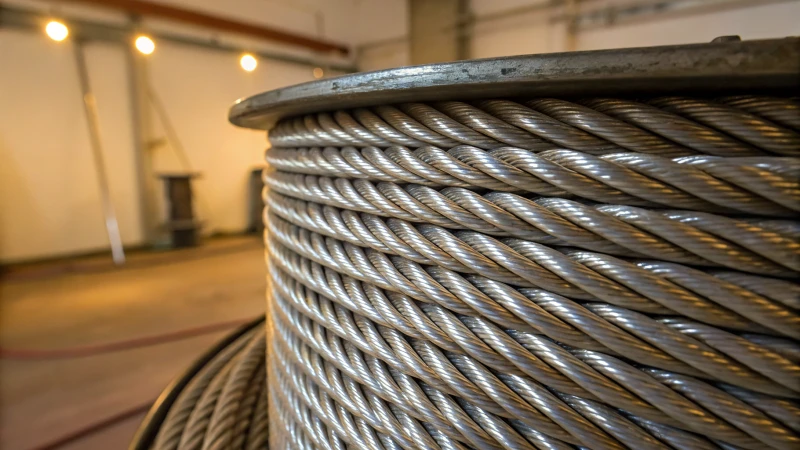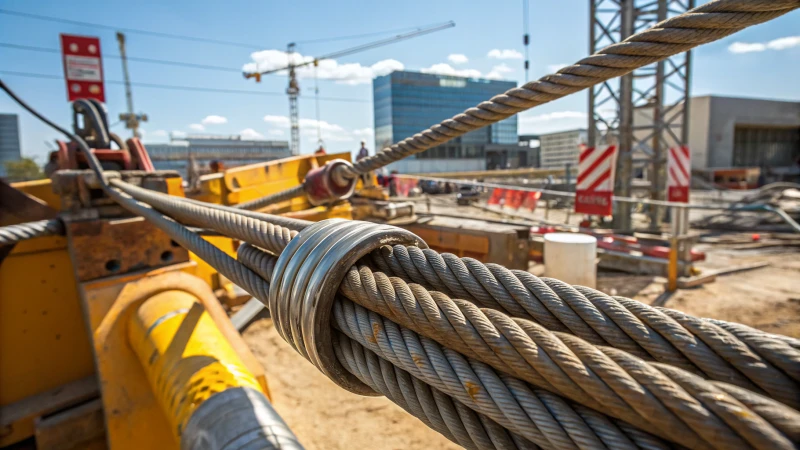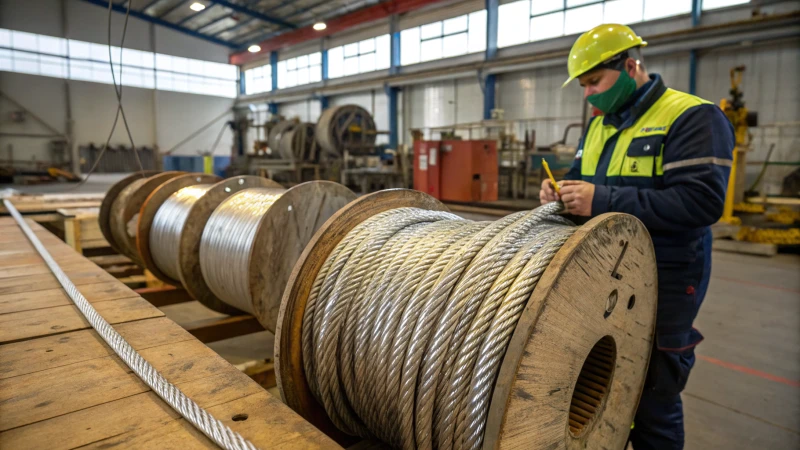
Imagine standing beneath a towering crane, its heavy machinery humming with potential, all supported by the invisible strength of steel wire ropes.
Steel wire ropes for heavy machinery can support loads up to 200 tons, varying with their design and materials. Factors like diameter, construction type, and material significantly influence their load capacity.
Remember that day on-site when I realized the importance of these details? We were lifting a massive beam, and the right rope made all the difference. It's not just about buying a rope; it's about choosing the one that ensures safety and reliability. In the next sections, I'll share what I've learned about selecting the perfect wire rope, focusing on safety standards and real-world performance.
Steel wire ropes can handle loads up to 200 tons.True
Steel wire ropes are designed to manage heavy loads, with capacities reaching 200 tons.
Diameter of steel wire rope does not affect load capacity.False
The diameter significantly influences the load capacity, affecting strength and performance.
How does steel wire rope construction impact its load capacity?
I remember the first time I learned about steel wire ropes and their fascinating construction. It opened my eyes to how much goes into ensuring safety and performance in industrial settings.
The construction of steel wire rope—its strands, wires, core type, and lay direction—directly impacts its load capacity. These elements define its tensile strength, flexibility, and environmental resilience.

Core Composition
Let me take you back to a project where I had to choose between different cores for steel wire ropes. It was a moment of revelation when I understood that the core isn't just about strength but flexibility too. Fiber cores offer flexibility, perfect for applications needing a bit more bend, though they may not support as much weight as steel cores.
| Core Type | Flexibility | Load Capacity |
|---|---|---|
| Fiber | High | Moderate |
| Steel | Moderate | High |
I found that a steel core1 was a no-brainer for heavy-duty tasks where load capacity was paramount. It's these decisions that ensure both safety and efficiency in demanding environments.
Strand and Wire Configuration
Imagine you're holding a rope and feeling its texture; it's not just about the touch but the construction underneath. With six strands of 19 wires each, a 6x19 configuration offers a solid mix of strength and flexibility. But when you opt for 6x37, the additional wires per strand give it more flexibility at a slight cost to its strength.
- 6x19 Construction: Comprising six strands of 19 wires each, offers a balance between flexibility and strength.
- 6x37 Construction: More wires per strand for higher flexibility but slightly reduced strength compared to 6x19.
The right configuration2 can make all the difference in applications where either strength or flexibility takes precedence.
Lay Direction
Then there's the lay direction, a detail often overlooked but crucial. Regular lay ropes twist wires opposite to the strand direction, perfect for frequent bending. Lang lay ropes, however, are twisted in the same direction, offering superior wear resistance—ideal for more abrasive or crushing scenarios.
- Regular Lay: Best for frequent bending environments.
- Lang Lay: Handles abrasion or crushing better.
Understanding lay direction3 is a game-changer when choosing the right rope for specific jobs.
Environmental Considerations
Environmental factors also play a pivotal role. Moisture, temperature, and chemicals can be relentless on materials. I recall a project in a marine environment where galvanized ropes proved invaluable for their corrosion resistance. In contrast, ungalvanized ropes were sufficient for drier, indoor settings.
Choosing the right construction elements enables us to select a steel wire rope with just the right balance of load capacity and resilience tailored to our needs.
Steel cores offer higher load capacity than fiber cores.True
Steel cores provide greater strength, enhancing the rope's load capacity.
6x37 construction offers more strength than 6x19.False
6x37 has more wires for flexibility but less strength than 6x19.
How Do You Choose the Right Steel Wire Rope for Heavy Lifting?
Choosing the right steel wire rope can feel like navigating a labyrinth, but getting it right is crucial for safety and efficiency.
When choosing steel wire rope for heavy lifting, focus on load capacity, environmental conditions, abrasion resistance, and fatigue life. These factors are key to ensuring safety and optimal performance in your operations.

Load Capacity and Strength
I remember the first time I had to decide on a steel wire rope for a big project. I was overwhelmed, but I quickly learned that understanding load capacity is fundamental. Manufacturers provide ropes with specific weight limits, and exceeding these can lead to catastrophic failures. The strength of a rope isn't just about size; it involves its diameter and construction.
- Diameter: Larger diameters generally offer higher strength.
- Construction: Common types include 6x19 or 6x37 configurations, each offering distinct flexibility and durability benefits.
Environmental Conditions
The environment where the rope will be used plays a significant role in its selection. I once worked on a project near the ocean, and boy, did that change things! Ropes used in marine or corrosive environments need extra protection.
- Galvanized Ropes: Offer better corrosion resistance.
- Stainless Steel Ropes: Ideal for harsh environments due to their superior corrosion resistance.
Abrasion Resistance
Steel wire ropes often face friction, which can lead to wear over time. Choosing a rope with high abrasion resistance can extend its lifespan and ensure consistent performance. I've seen this firsthand when we opted for coated ropes in a project involving lots of movement.
- Coatings: PVC or nylon coatings can offer additional protection against abrasion.
Fatigue Life
Fatigue life refers to the rope's ability to withstand repeated bending and stress without breaking. It's vital in applications involving pulleys or sheaves. During one of my projects, we had to replace ropes because they weren't designed for frequent use, costing us time and money.
- Fatigue-Resistant Ropes: Designed with specific wire arrangements to enhance endurance.
Table: Factors Affecting Rope Selection
| Factor | Consideration |
|---|---|
| Load Capacity | Diameter, construction type |
| Environmental Impact | Galvanization, material choice |
| Abrasion Resistance | Coating type |
| Fatigue Life | Rope configuration, intended application |
Consider these factors carefully to ensure that your steel wire rope meets operational needs while maintaining safety standards. For more details on specific rope construction types4, review manufacturers' guidelines and consult experts in the field.
Industry Standards and Safety Regulations
Adhering to industry standards is crucial for ensuring the safety and reliability of your lifting operations. Organizations like OSHA and ISO provide guidelines that should be followed when selecting steel wire ropes.
- OSHA Regulations: Ensure ropes meet specific safety standards for construction and heavy lifting.
- ISO Standards: Provide a global benchmark for quality and performance in various industries.
Referencing these standards ensures compliance with legal requirements and enhances operational safety. For further reading on global safety regulations5, consult relevant industry publications and resources.
Larger diameter ropes offer higher strength.True
Larger diameters generally provide greater strength due to increased material.
Stainless steel ropes are unsuitable for harsh environments.False
Stainless steel ropes are ideal for harsh environments due to corrosion resistance.
What Safety Standards Govern Steel Wire Ropes in Heavy Machinery?
Navigating the world of heavy machinery, I've often marveled at the strength and resilience of steel wire ropes. But what keeps them reliable under immense pressure?
Absolutely, safety standards do exist for steel wire ropes in heavy machinery. Organizations like OSHA and ISO establish guidelines addressing load capacity, construction quality, and regular inspections to ensure they perform safely and effectively.

Understanding Key Safety Standards
I've always been fascinated by how specific standards govern the use of steel wire ropes in heavy machinery. These standards, crafted by groups like OSHA6 and ISO7, aren't just about rules—they're about keeping operations safe and sound.
-
Load Capacity: I recall a time when we had to lift a massive load using a crane. The importance of having a rope that could handle the maximum expected load was crystal clear. Knowing that the ropes are rated for such heavy-duty tasks gives peace of mind.
-
Construction Specifications: The way a rope is made—its materials and construction—determines if it can withstand the harsh environments we put it through daily. It's like knowing your car's engine won't fail you on a long road trip.
Regular Inspection and Maintenance Protocols
Routine checks are my best friends when it comes to maintaining rope integrity. Inspection protocols8 include both visual checks and more technical, non-destructive testing for hidden damages.
| Inspection Checklist | Frequency |
|---|---|
| Visual Inspection | Weekly |
| Load Testing | Monthly |
| Non-Destructive Test | Quarterly |
Sticking to these schedules helps spot wear early—preventing the potential chaos of accidents.
The Role of Safety Certifications
Getting certified isn't just a box to tick—it's proof that we meet the high standards necessary for safety and quality. Certifications like ISO 90019 ensure our processes are top-notch.
- ISO Certifications: These prove that products meet international standards, which is reassuring when sourcing.
- OSHA Compliance: Ensures workplace health and safety regulations are followed.
Understanding these certifications helps me choose suppliers who prioritize safety and quality just as much as I do.
Importance of Supplier Selection
Choosing the right supplier feels like picking a trustworthy partner. I need suppliers who not only provide detailed compliance documentation but also stand by their product with solid after-sales support.
Factors to Consider:
- Compliance Documentation: Ensuring every necessary document is provided by the supplier is crucial.
- Technical Support: Opting for suppliers who offer technical assistance and training for proper rope handling is invaluable.
These considerations ensure I source steel wire ropes that not only meet but exceed industry expectations, minimizing risks of equipment failure or accidents due to non-compliance.
OSHA sets standards for steel wire rope load capacity.True
OSHA provides guidelines to ensure wire ropes can handle expected loads.
ISO certifications are not required for steel wire ropes.False
ISO certifications ensure compliance with international safety and quality standards.
How Can You Maintain Steel Wire Ropes to Ensure Maximum Load Capacity?
Steel wire ropes are the unsung heroes of heavy lifting, tirelessly holding it all together. Just like us, they need a little TLC to keep doing their job without a hitch.
To keep steel wire ropes in top shape, inspect them regularly for any signs of wear, corrosion, or damage. Lubricate them properly to minimize friction and store them in a dry place to prevent rust. These steps ensure they maintain their strength and load capacity.

Regular Inspections and Monitoring
I remember the first time I realized the importance of regular inspections. I was new to managing equipment and thought a quick glance was enough. But one day, a small kink nearly escalated into a major issue. From then on, I made it a point to thoroughly check for broken wires, strands, or corrosion and document everything in a maintenance log10. It felt like my version of a diary—keeping track of potential issues before they became real headaches.
Proper Lubrication
In my experience, proper lubrication is like giving your ropes a spa day. Initially, I underestimated how vital this was until I noticed increased wear and tear from friction. Now, I ensure we use the right lubricants designed for wire ropes and apply them regularly to maintain optimal performance11. It's amazing how a little effort can not only extend the life of the ropes but also boost their load capacity.
Storage Conditions
Picture this: You've done all the hard work, and then neglect storage. I've learned that storing wire ropes in clean, dry areas is non-negotiable. Moisture is their kryptonite, leading to rusting faster than you'd think. Using reels or spools prevents tangling and saves us from a lot of physical damage by keeping them rust-free12.
Handling Practices
Handling these ropes gently is like moving precious cargo. Early on, I saw how improper handling caused unnecessary strain and deformation. Using proper equipment like forklifts13 with protective sleeves has become second nature for me now.
Maintenance Schedule
Creating a maintenance schedule felt like organizing my life on a planner. It’s essential to keep everything on track based on usage and conditions. Updating this schedule regularly helps me adhere to industry standards while ensuring the ropes are performing at their best.
| Maintenance Task | Frequency | Notes |
|---|---|---|
| Visual Inspection | Monthly | Check for visible damage |
| Lubrication | Every 3 months | Use appropriate lubricant |
| Storage Check | Bi-annually | Ensure dry environment |
| Full Audit | Annually | Detailed condition report |
Following these steps has helped me keep our steel wire ropes reliable and safe under maximum load conditions. It's not just about maintaining equipment; it's about ensuring smooth operations and peace of mind.
Regular inspections prevent wire rope hazards.True
Consistent inspections detect wear early, preventing potential hazards.
Storing ropes in wet areas enhances their lifespan.False
Moisture leads to rust, reducing the lifespan of steel wire ropes.
Conclusion
Steel wire ropes for heavy machinery can support loads up to 200 tons, influenced by factors like diameter, construction type, and material, ensuring safety and reliability in operations.
-
Explore this link to understand how different core types impact the load capacity and flexibility of wire ropes. ↩
-
Find detailed information on how varying strand configurations affect the performance of steel wire ropes. ↩
-
Learn about the differences in lay directions and how they influence the wear resistance and fatigue strength of wire ropes. ↩
-
Understanding various rope constructions helps you select the right type for your specific lifting needs. ↩
-
Learn about international standards to ensure compliance and enhance safety in lifting operations. ↩
-
Learn how OSHA guidelines ensure safe use of steel wire ropes in industrial settings. ↩
-
Discover the global standards set by ISO for steel wire rope quality and performance. ↩
-
Find out recommended practices for inspecting steel wire ropes to maintain safety. ↩
-
Explore how ISO 9001 certification guarantees manufacturing quality of steel wire ropes. ↩
-
Keeping a maintenance log helps track inspections and repairs, ensuring the rope's longevity and safety. ↩
-
Discovering suitable lubricants can reduce wear and friction, thus enhancing the performance of wire ropes. ↩
-
Preventing rust is crucial for maintaining the structural integrity and load capacity of steel wire ropes. ↩
-
Proper handling techniques minimize physical damage and ensure safe and efficient rope management. ↩

